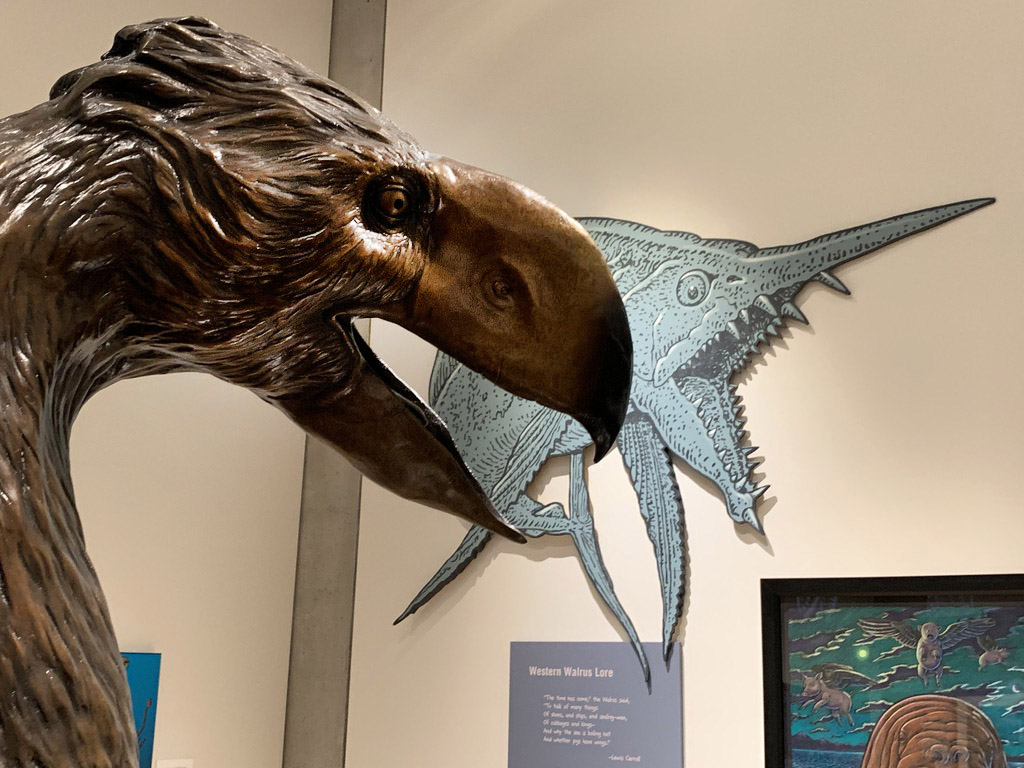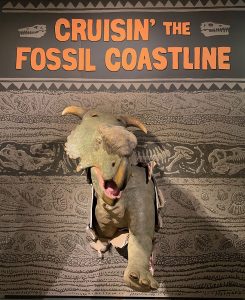Juneau Empire article about Cruisin’ the Fossil Coastline exhibit

Dig this: Art and science collide in new Ray Troll exhibition
Ray Troll and friends’ work comes to Alaska State Museum
Juneau Empire, May 4, 2019 by Ben Hohenstatt
Ray Troll is a paleo hipster.
The Ketchikan artist many in Southeast Alaska know for his fish pun T-shirt designs liked the Earth before it was cool and is keenly interested in underground rocks.
“I’ve been a paleo nerd for my entire life,” Troll said in an interview with the Capital City Weekly. “I never gave up loving dinosaurs. Everything prehistoric. For me it’s kind of a mission to get people turned on to a prehistoric past. I think it’s really important for people to know the history of the Earth.”
Troll is willing to go to the mats for lesser-known prehistoric creatures, such as the Tully monster — a confusing ancient aquatic animal that defies easy classification — and desmostylians — a line of marine mammals that went extinct. Desmostylians’ range included Alaska, and the animals are thought to have resembled a hippo-walrus hybrid.
“We call them desmos for short,” Troll said.“Only the connoisseurs of paleo nerdom know about them. Some of them were the size of elephants.”
Troll’s interest in paleontology goes as far back as he can remember. He said his earliest artistic memory is drawing a dinosaur with a crayon at age 4. “I’m 65 years old, and I’m still drawing dinosaurs,” Troll said.
That lifelong fascination helped lead to a 26-year-and-counting friendship with paleontologist Kirk Johnson, now director of the Smithsonian National Museum of National History, and an expansive fossil-hunting road trips along North America’s coast.
That 10,000-mile, 250-day trip led to “Cruisin’ the Fossil Coastline,” a traveling exhibition organized by the Anchorage Museum that will be in Juneau at the Alaska State Museum through Oct. 19, and a book of the same title.
“This is the second book with Kirk,” Troll said. “We’ve probably driven around the Earth together. We’ve done trips to the Amazon and all over the west. He shared a lot of his knowledge with me and vice versa.”
Troll is an artist with evident exuberance for ancient plants and animals, and Johnson is a scientist who was once an art major.“He’s the scientist I always wanted to be, and I’m the artist he wanted to be,” Troll said. “It’s a melding of two disciplines.”
The cross-pollination of science and art is evident in the pieces in the “Cruisin’ the Fossil Coastline.” During a docent tour previewing the exhibition, Troll was able to point out era-appropriate plants in his work and explain the anatomy of the long-dead creatures the pieces depict. Troll said the exhibition has been tailored for its Juneau audience and most of the pieces on display are related to animals that millions of years ago thrived in Alaska.
 “This represents about 10 years worth of work, and there are about 60 pieces of art in the exhibit,” Troll said. ” Thirty of them being original framed pieces and the other 30 being digital outputs. “Cruisin’ the Fossil Coastline” also features some works not made by Troll, including a pachyrhinosaurus statue made by Gary Staab that depicts the triceratops-like dinosaur bursting through the museum wall that seems destined to be a selfie backdrop.
“This represents about 10 years worth of work, and there are about 60 pieces of art in the exhibit,” Troll said. ” Thirty of them being original framed pieces and the other 30 being digital outputs. “Cruisin’ the Fossil Coastline” also features some works not made by Troll, including a pachyrhinosaurus statue made by Gary Staab that depicts the triceratops-like dinosaur bursting through the museum wall that seems destined to be a selfie backdrop.
The exhibition also included a handful of fossils, including bones from ichthyosaurs — an enormous marine reptile that swam the waters of Southeast Alaska. “They were the size of dinosaurs, but they were in the water,” Troll said. “We’ll show some massive ribs and some vertebrae from those. I think it will blow some minds that we had these right in Southeast Alaska.”
The collection also includes what Troll considers the pinnacle of his fossil-hunting exploits: the tooth of a Nanuqasaurus. Nanuqasauruses were a tyrannosaur that lived around the North Slope, and Troll found a tooth from one of the carnivores on the banks of the Colville River.
“It was a big moment for me,” Troll said. “When I found it, I cried.”
Know & Go
What: “Cruisin’ the Fossil Coastline.”
Where: Alaska State Museum, 395 Whittier St.
When: The exhibition will be up through Oct. 19. Summer hours are 9-5 p.m. daily and begin May 6.
Admission: Admission is $12 for adults, $11 for seniors and free for those 18 and younger.
